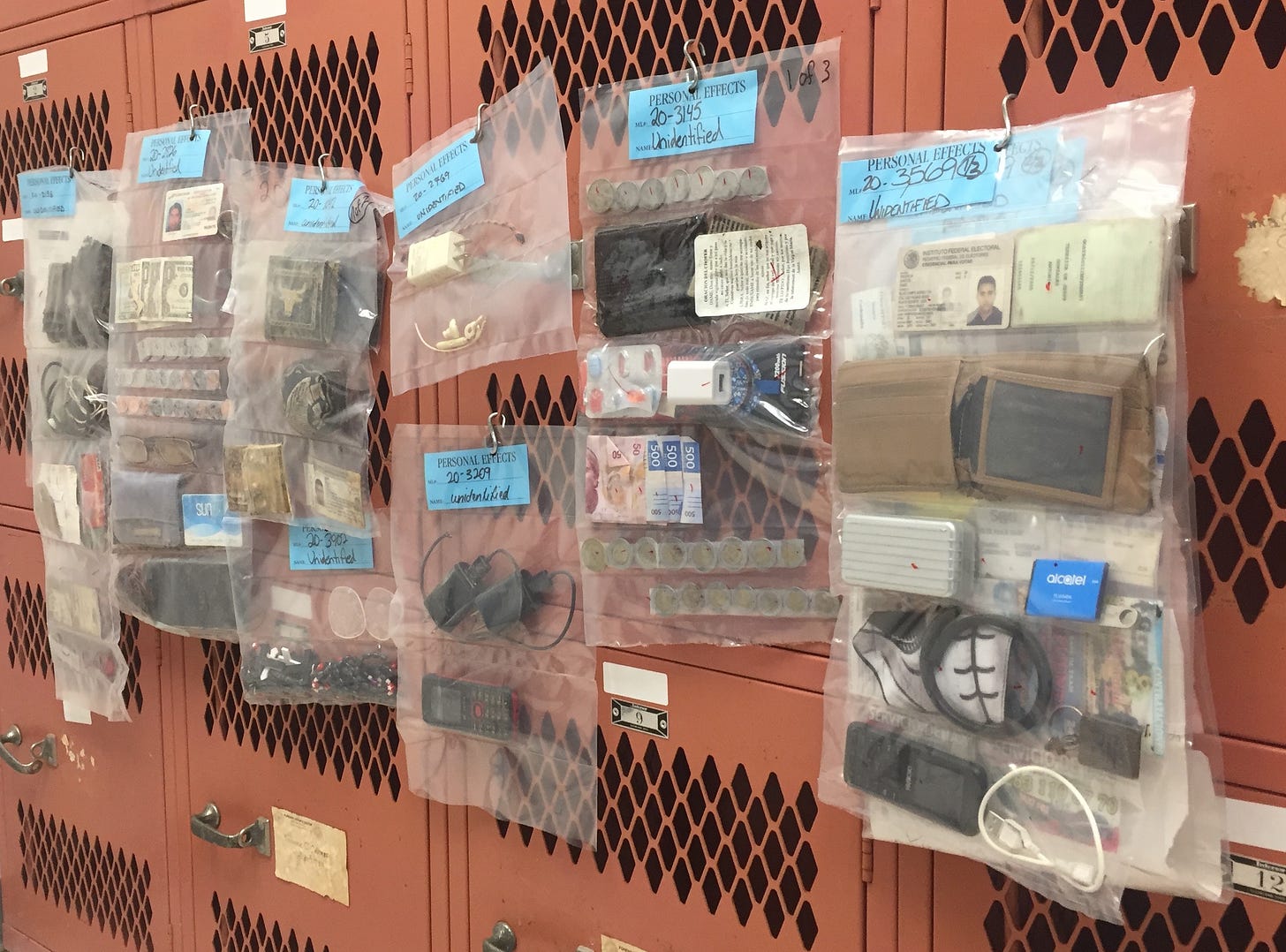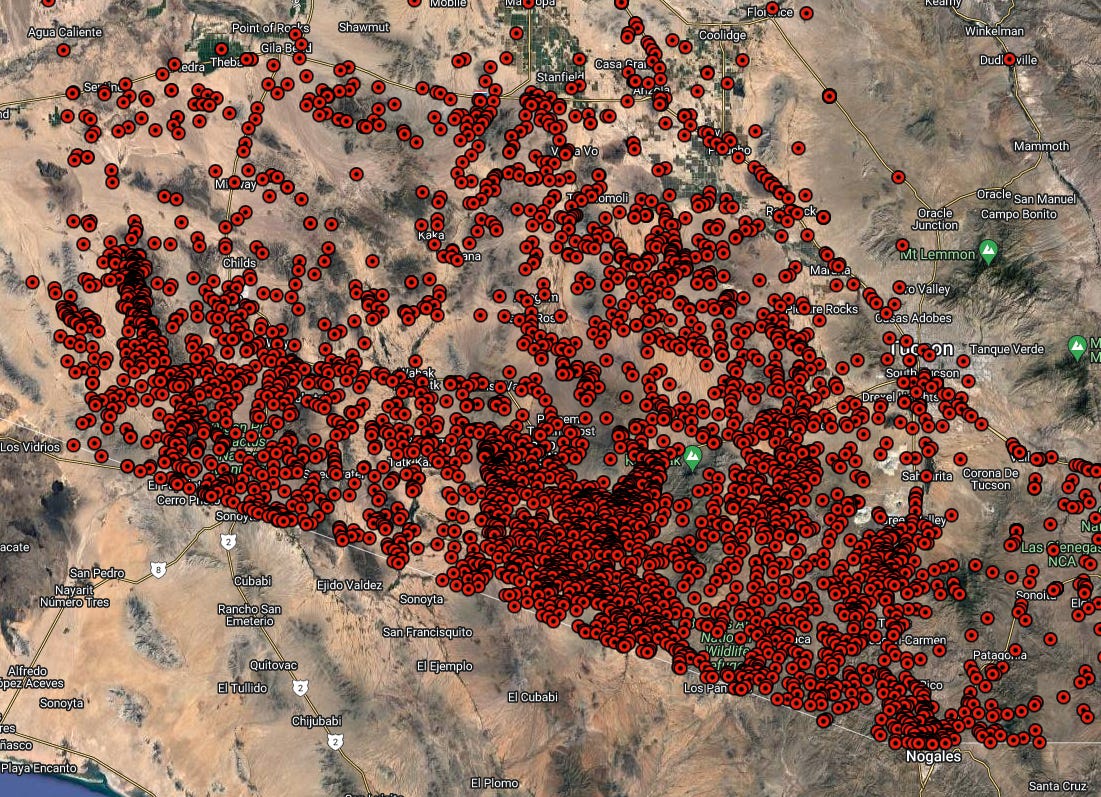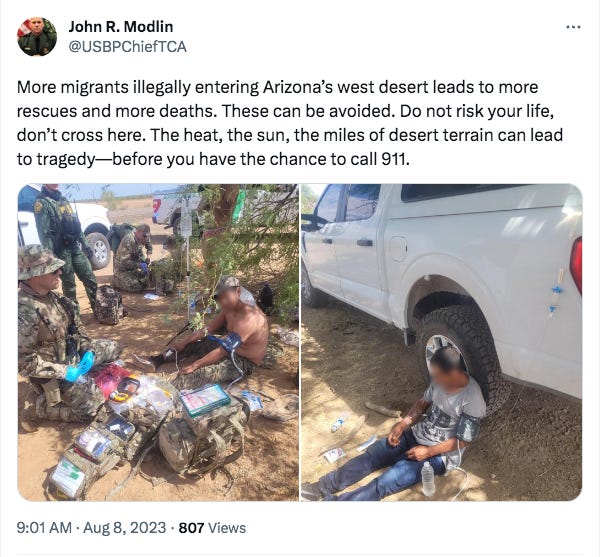The Daily Agenda: Deadly cycle repeats in the desert
Last month’s heat was deadly for migrants ... Same story every year ... Groundwater control legislation prompts dueling op-eds.
We’ve partnered with the Children’s Museum of Tucson to promote their October fundraising gala, Evening of Play. The museum is a nonprofit that provides hands-on, fun, educational opportunities to thousands of kids in our community each year. We’re happy to help them spread the word about their big fall fundraiser. Get your tickets now before the summer sale ends on August 31.
Click on the image above to learn more or purchase tickets.
And if you’d like to get the word out about your business, event or organization, we have good news! The Tucson Agenda and Arizona Agenda are opening up sponsorship/advertising opportunities. Click on the button to get in touch.
The Tucson area just ended 53 days in a row where the temperature rose above 100 degrees.
The hardest part for many Tucsonans might have been a scorching-hot steering wheel or irritation at having to stay inside for the day.
Now imagine what it was like trudging through the desert and along steep mountain trails for days on end with only the water and food you can carry. Even at night, the low temperature averaged 80 degrees in July, making it harder to recover from the heat of the day.
As the summer heat has done for many years, it turned deadly for migrants as they crossed the border and made their way to Tucson, Phoenix or pickup spots on the highways that criss-cross Southern Arizona.
In July alone, heat caused the deaths of 22 people while they crossed the border in Southern Arizona, the Pima County Office of the Medical Examiner reported.
That’s one more than the 21 heat-caused deaths among the 1 million-plus people who live in Pima, Cochise, La Paz and Graham counties.

Not only did Southern Arizona see record-setting heat in July, the Border Patrol’s Tucson Sector, which covers most of the Arizona-Mexico border, was busier than it’s been since 2008. Agents made about 40,000 apprehensions in July.
So far this year, the medical examiner reported the remains of 103 migrants in Southern Arizona, including 35 in July. Another 171 were found last year.
At least 4,000 migrants have died in Southern Arizona since the crackdown on illegal border crossings began in the late 1990s.
The scale of the tragedy has been well documented over the past two decades, including by Curt and former Arizona Daily Star reporter Alex Devoid in 2021, but indifference from policymakers allows it to continue.
The cycle repeats itself every year. Most migrants do not have a legal way to cross the border, so they cross wherever they can. When the desert temperature stays so hot week after week, the desert turns deadly.
We will continue to hold people accountable for these long-running tragedies. That takes time and money. Help us stay in business by upgrading to a paid subscription.
This has gone on for so long the medical examiner’s office has developed expertise in estimating how long human remains have been in the desert.
Last month, 18 of the bodies were found within a day of the person dying. Migrants in distress make heartbreaking 911 calls, and agents, deputies or volunteers race to the area where the call came from.
The cycle doesn’t have to continue. There are meaningful steps officials can take. In 2021, Curt and Alex came up with possible solutions:
Pass laws aimed directly at lessening migrant deaths. Years ago, lawmakers would at least acknowledge that people shouldn’t be dying at our borders. That talk has faded away, dimming the hope for large-scale efforts to save lives. Lawmakers need to look directly at the problem and fix it.
Put someone in charge. Various groups and agencies try to save migrants’ lives, but they work across 20 jurisdictions that cover an area bigger than many states. Somebody needs to be in charge of coordinating all those efforts and to be held accountable.
Share data to help rescuers get to migrants in distress faster. As we noted earlier, 18 migrants died last month just hours before help arrived. A strong data program could find patterns in where distress calls are made and work out how to speed up response times, which could save lives.
Expand cell phone coverage in the desert west of Tucson. The remains of more than 500 migrants have been found in remote areas without cell phone coverage. That means they didn’t even have a chance to call for help.
Process more asylum seekers at ports of entry. Border Patrol agents spend a lot of time processing large groups of asylum seekers who flag down agents immediately after crossing the border, as the Tucson Sector chief highlighted several times in July. If officials let more people ask for asylum at ports of entry, it would free up Border Patrol resources.
The number one thing our leaders need to do is decide to take this seriously. Without their action, the deadly cycle will just keep repeating itself year after year.

RTA roadblock: Rising cost estimates and conflicting viewpoints have slowed progress on a massive 20-year transportation plan designed to build Pima County’s infrastructure, the Arizona Daily Star’s Nicole Ludden reports. Voters approved a Regional Transportation Authority ballot measure in 2006, with a half-cent sales tax projected to fund $2 billion in transportation projects. But revenue has been much lower than expected, leaving an estimated $500 million shortfall to complete projects promised to voters nearly two decades ago.
A trip down memory lane: University of Arizona researchers have found that brain waves can be directly linked to memory and that triggering memories can help patients overcome cognitive impairments resulting from a stroke or other brain-related issues, Arizona Public Media’s Tony Perkins reports. The research, which explored how rhythmic sounds and sights generate brain activity, could also help patients dealing with the effects of Parkinson’s disease and seizures.
Gloves off: The Sierra Vista Herald published a pair of dueling op-eds penned by government officials about water in Cochise County. The first, written by LD19 Rep. Gail Griffin, said that proposed rural groundwater control legislation would be bad for the state, as the “bills would allow as few as two people in some counties to establish irreversible groundwater control districts throughout the county.” The second, which was authored by Mohave County supervisor Travis Lingenfelter and ran two days after Griffin’s piece, said that the Republican lawmaker was misleading the public and had included “blatant lies” in her op-ed.
“The real reason she hasn’t allowed even one public hearing on the multiple water bills that have been introduced is that she cannot publicly defend her policy positions during public debate and discussion,” Lingenfelter wrote. “It’s easier for her to never let the bills see the light of day.”
Funding outside education: Over in Sierra Vista, the city council approved a resolution to issue $65 million in revenue bonds to a pair of charter schools located in Las Vegas and the Phoenix area, Arizona Public Media’s Summer Horn writes. State law allows for the Industrial Development Authority of Sierra Vista, the group that proposed the initiative, to issue bonds to borrowers outside of Arizona.
Nobody is issuing revenue bonds to fund the Tucson Agenda, so we’re going to have to keep asking you to support local journalism and help fund our newsroom.
Gentrification or bust: South Tucson officials are considering filing an injunction against the owners of a low-end apartment complex, forcing them to better handle a crime problem at that property and another they own nearby, the Star’s Tim Steller writes. The city council is also weighing legal action that declares the buildings blighted properties and allows for their redevelopment, posing the larger question of whether the city should seek development or try to sustain the city’s low-end housing for existing, mostly low-income residents. Three of the seven council members won last year on a platform of resisting gentrification, so the discussion is likely far from over.
2.04: The total inches of rainfall recorded this monsoon season in Tucson through August 12. The normal amount of rainfall through that date is 3.23”, according to the National Weather Service.










Yes, the article was spot on about how to prevent deaths in the desert. Even in one area--Search and Rescue--there are solutions that no one is discussing. Currently, all 911 calls involving migrants are routed to Border Patrol. Since Border Patrol is overwhelmed and understaffed, many 911 calls could be routed to Pima County Sheriff Department (PCSD), which has a large and well-resourced volunteer SAR unit (I was a member). Or Border Patrol could facilitate the creation of a volunteer SAR auxiliary, modelled after the one attached to PCSD. If nothing else, BP could respond with less hostility and more transparency to the haphazard and decentalized efforts of local humanitarian organizations to rescue migrants.
Thank you for the report and the map of migrant deaths. Both are heartbreaking. Now we voters need to do what Pamela Powers recommends: find, support, and fund legislative candidates who will champion the list of actions you included.